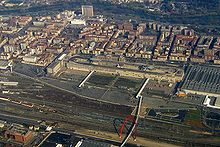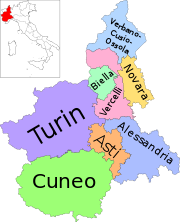Polytechnic University of Turin
Politecnico di Torino | |
| File:Polito logo.gif | |
| Rector | Prof. Marco Gilli |
|---|---|
| Students | 32,100 |
| Location | , |
| Campus | Corso Duca degli Abruzzi, 24, Torino 10129 |
| Sports teams | CUS Torino (http://www.custorino.it/) |
| Affiliations | ESDP, TIME, CLUSTER, PEGASUS, CESAER |
| Website | www.polito.it/ |
The Politecnico di Torino (Polytechnic University of Turin) is an engineering public university based in Turin, Italy. Established in 1859, Politecnico di Torino is Italy’s oldest technical university. The university offers several courses in the fields of Engineering, Architecture and Industrial Design.
History
The Regio Politecnico di Torino (Royal Turin Polytechnic) was founded in 1906, but its origins go back further. It was preceded by the Scuola di Applicazione per gli Ingegneri (Technical School for Engineers) founded in 1859 after the Casati Act and the Museo Industriale Italiano (Italian Industry Museum) founded in 1862 under the aegis of the Ministry of Agriculture, Trade and Industry. The Technical School for Engineers was part of the University, which led to technical studies being accepted as part of higher education. The country was about to begin a new industrial era, which the Industry Museum was to address more directly. Famous scholars and researchers, authorities in different subjects with characters to match, gave a decree to new subjects such as electrotechnics and building science. They were the first to have a vision of founding a school which dealt with the needs of people and society.
Following the model of the most famous European Polytechnic Schools, at the beginning of the 20th century the Regio Politecnico di Torino had various objectives. It began to contact both the European scientific world and local and national industry. Aeronautics began as a subject. Students from all over Italy came to Turin and found in the new laboratories built for the study of everything from chemistry to architecture in a lively and resourceful atmosphere. The future was already at hand. In the 1990s, new teaching campuses were opened in Alessandria, Aosta, Biella, Ivrea, Mondovì and Vercelli.
For more than 150 years, the Politecnico di Torino has been one of the most prestigious public institutions at both the International and the Italian levels concerning education, research, technological transfer and services in all sectors of architecture and engineering.
The Politecnico di Torino was founded in 1859 as Scuola di Applicazione per gli Ingegneri (Technical School for Engineers), and it became Regio Politecnico di Torino in 1906. A long history, which bore out the University as a reference point for education and research in Italy and in Europe, a Research University of international level which attracts students from more than 100 countries and which activates about 800 collaborations per year with industries, public institutions and local organizations.
The attention to theoretical and applied research, the knowledge and development of cutting edge technologies, the concreteness and realism concerning the management of a manufacturing process or the organization of a service, the care of functionality without ignoring design, the analysis and proposition of solutions to the challenges of the society of today in order to plan a sustainable future: graduates from the Politecnico di Torino receive an education that goes far beyond technical knowledge. They are able to manage the interdisciplinary nature of the scientific world of today without forgetting social, ethical, economic and environmental implications.
Excellent results in education and research fields, positive judgments from students, education processes of quality and the ability in winning national and European grants brought the Politecnico di Torino to an excellent place in the assessment drawn up by the Italian Ministry of Education, Universities and Research (MIUR): since 2010, when the MIUR began to award the public funding of the Fondo di Finanziamento Ordinario according to a table on Universities performances, the Politecnico has always been the first University in Italy. A positioning proved by the good results of the University at the European level.
Campuses
Campuses of the Politecnico di Torino draw inspiration from the structure of Anglo-Saxon ones, with multipurpose buildings for teaching, basis and applied research and services to the students in Turin, and a regional network of technological centers (Alessandria, Biella, Mondovì, Vercelli, Verrès), dedicated to research activities, technological transfer, specialist education and services to the region.
The historical and representative base of the Politecnico is in the town, on the River Po: the Castle of Valentino, a House of Savoy of the 17th Century. It is the main teaching campus for Architecture and has an area of 23.000 sq. m.
The big complex in corso Duca degli Abruzzi - with 122.000 sq. m., the main campus of Engineering - was opened in 1958 and it is completed by the Cittadella Politecnica: a modern complex of 170,000 sq. m. adjoining to the main building, including areas dedicated to students, research activities, technological transfer and services.
The newest campus is the Design and Sustainable Mobility Citadel, in an area adjoining to the manufacturing establishment of Mirafiori, FIAT manufacturing facility which has been remodeled as well as the Lingotto building, which hosts the Master School.
Students and teaching




STUDENTS
- 32.000 students (A.Y. 2012/2013)
- 30% women
- 42% students from outside Piedmont
- 16.5% international students
- 4.900 first year students (A.Y. 2012/2013)
- 12% first year international students
- 400 Specialization Master students
- 633 PhD students (A.Y. 2012/2013)
PROGRAMS
- 28 Degree programs (first cycle level - Bachelor)
- 32 MS Degree programs (second cycle level - Master)
- 18 Courses completely in English
- 6 I level Specialization Masters
- 27 II level Specialization Masters
- 24 PhD programs
- 6 Advanced training programs
- 1 Specialization program
GRADUATES5,371 graduates in 2012
- 2.802 first cycle (Bachelor) level graduates
(average age: 24 years old)
- 2.569 second cycle (Master) level graduates
(average age: 26 years old)
Employment rate of second cycle (Master) students one year after graduation (Almalaurea - def. ISTAT-Workforce): 74.5% (above the national average of 60%) 42% have permanent contracts (above the national average of 34%)
The world of research
The Politecnico is a "Research University" aknowledgeded as a centre of excellence in all over the world for the qualifying research areas of Architecture and Engineering. The development of the fields of excellence, the investment on frontier subjects, and also the support to the curiosity driven research allow a virtuous mix of basis and applied research.
Research activities, in particular, are structured in four macro-areas: Industrial Engineering; Information Technology; Management and Mathematical Engineering; Civil, Environmental, Architecture and Design Engineering.
DEPARTEMENTS
The two souls characterizing Departments are research and teaching. Departments indeed carry out duties of coordination, promotion of research, organization and management of the teaching activity, following the recent reform of the University system.
- DAD - Department of Architecture and Design
- DAUIN - Department of Control and Computer Engineering
- DENERG - Department of Energy
- DET - Department of Electronics and Telecommunications
- DIATI - Department of Environment, Land and Infrastructure Engineering
- DIGEP - Department of Management and Production Engineering
- DIMEAS - Department of Mechanical and Aerospace Engineering
- DISAT - Department of Applied Science and Technology
- DISEG - Department of Structural, Geotechnical and Building Engineering
- DISMA - Department of Mathematical Sciences
- DIST - Interuniversity Department of Regional and Urban Studies and Planning
Internationalization
The Politecnico di Torino has long faced the biggest international technical schools in education and research fields. The first agreements date back to nineties and their number increased very soon thanks to collaborations on student mobility.
The University was able to create a true international and multicultural environment and a world research network on the main subjects of reference by strengthening education in English; supporting international mobility of students and teachers; attracting foreign students, doctoral students, and researchers; taking part in combined research projects and programs.
A Politecnico's network of campuses abroad strengthens international relations with countries whose collaboration has strengthened over the years, especially with China, where the Italan-Chinese campus in the Tongji University of Shanghai is active since 2006. The most of the foreign students of the Politecnico are from China and the collaboration with the Asian country recently expanded also to research fields, especially after the creation in Beijing, under the aegis of the Italian Ministry of the Environment, of the Center EC2 - EU-China Clean Energy Center, for the implementation of the use of renewable energy sources in the country.
Courses
The main courses offered are architecture, architectural engineering, industrial design, aerospace engineering, automotive engineering, biomedical engineering, chemical engineering, civil engineering, computer engineering, electrical engineering, electronic engineering, environmental engineering, energy engineering, engineering physics, material engineering, mechanical engineering, mechatronics, nuclear engineering, nanotechnology, production engineering, petroleum engineering, telecommunications engineering and textile engineering.
Research
Research alliances

The Polytechnic has research links with local and international companies, reaching about 700 yearly research contracts with firms such as Thales Alenia Space, Intel, Motorola, Compaq, Ferrari, Fiat, Finmeccanica, General Motors, Telecom Italia, Freescale, Vishay, Avio, Agusta, IBM, Microsoft, Nokia, Pininfarina, Bosch, General Electric, STMicroelectronics and ESA.
Networks
The Politecnico di Torino is a member of
- CESAER (Conference of European Schools for Advanced Engineering Education and Research). CESAER is the association encompassing 57 leading European universities of technology committed to engineering education that is based on excellent research and close cooperation with industry and other societal actors.
- CLUSTER (Consortium Linking Universities of Science and Technology for Education and Research) which is a network of leading European Universities of Technology
- European Network for Training and Research in Electrical Engineering
- Top Industrial Managers for Europe (TIME) network
- European Spatial Development Planning (ESDP) network.
Ranking
According to ARWU Ranking 2013, Politecnico Di Torino is 1st in Italy and 7th in Europe for Engineering. [1] and in the same year according to QS World University Rankings among the engineering universities it was ranked 68th in the world (within top 15 in Europe) [2] and for electrical engineering the university was ranked 1st in Italy, 8th in Europe and 30th in the world.[3]
University's Innovative Enterprise and Business Incubator 'I3P' was recently ranked as the 4th best in Europe and 11th overall in the world by UBI Index [4]
Politecnico Di Torino is 1st in Italy when it comes to awarding of Public funds of Fondo di Finanziamento Ordinario according to a table on Universities performances, thus receives the highest funding in Italy. [5]
Its Automotive Engineering program, conceived in collaboration with Fiat Group, has been consistently ranked among the top three in Europe for the past ten years[when?][citation needed]. Turin is the seat of Fiat, Italy's largest car manufacturer which also includes Ferrari, Maserati, Chrysler and Jeep.
Professional opportunities
Most of the graduates find jobs within a year from graduation.[6] A special section called Stage&Jobs has been created to improve contact between students and industry.
See also
External links
- Politecnico di Torino Website Template:It icon Template:En icon
- Politecnico di Torino in Scientific American Template:En icon
- CLUSTER (Consortium Linking Universities of Science and Technology for Education and Research) Website Template:En icon
- CESAER
Notes and references
- ^ Academic Ranking of World Universities in Engineering/Technology and Computer Sciences-2012 Template:En icon
- ^ QS World University Rankings 2012: Politecnico di Torino Template:En icon
- ^ QS World University Rankings by Subject 2013 Engineering & Technology - Electrical Engineering Template:En icon
- ^ [1] Template:En icon
- ^ [2] Template:En icon
- ^ Politecnico di Torino: At a glance Template:En icon

